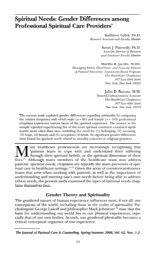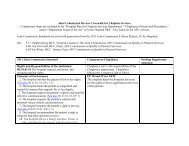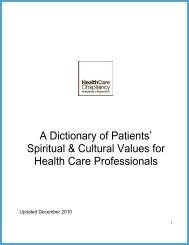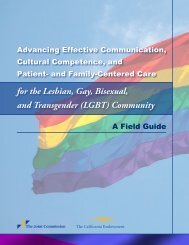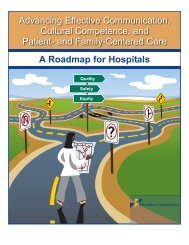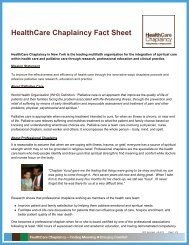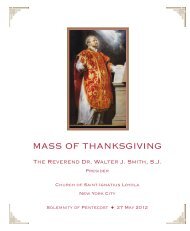Spiritual Care, Pastoral Care, and Chaplains - HealthCare Chaplaincy
Spiritual Care, Pastoral Care, and Chaplains - HealthCare Chaplaincy
Spiritual Care, Pastoral Care, and Chaplains - HealthCare Chaplaincy
Create successful ePaper yourself
Turn your PDF publications into a flip-book with our unique Google optimized e-Paper software.
<strong>Spiritual</strong> <strong>Care</strong>, <strong>Pastoral</strong> <strong>Care</strong>, <strong>and</strong><br />
<strong>Chaplains</strong>: Trends in the Health <strong>Care</strong><br />
Literature<br />
Stephen R. Harding, STM, BCC<br />
Kevin J. Flannelly, PhD<br />
Kathleen Galek, PhD<br />
Helen P. Tannenbaum, MBA, MLIS<br />
ABSTRACT. This study analyzes trends in the health care literature<br />
based on electronic searches of MEDLINE between the years 1980<br />
<strong>and</strong> 2006. The search terms used were ‘‘spiritual care,’’ ‘‘pastoral<br />
care,’’ <strong>and</strong> ‘‘chaplain. ’’ The results document an expected surge in<br />
the rate of English-language journal articles about spiritual care beginning<br />
in the mid 1990s. Although the rate of articles about pastoral care<br />
was several times higher than that for spiritual care over much of the<br />
study period, there was a steady decline in articles about pastoral care<br />
during the past 10 years. These two trends produced a convergence in<br />
the rates, so by 2006 the rate of published articles on pastoral care<br />
(21.1 per 100,000) was less than twice as high as that on spiritual care<br />
Stephen R. Harding, STM, BCC, is Director of <strong>Pastoral</strong> <strong>Care</strong> at NYU<br />
Medical Center, New York, NY.<br />
Kevin J. Flannelly, PhD, is Associate Director of Research for The<br />
Health<strong>Care</strong> <strong>Chaplaincy</strong>, New York, NY.<br />
Kathleen Galek, PhD, is a Research Associate at The Health<strong>Care</strong><br />
<strong>Chaplaincy</strong>.<br />
Helen P. Tannenbaum, MBA, MLIS, is Research Librarian at The<br />
Health<strong>Care</strong> <strong>Chaplaincy</strong>.<br />
Address correspondence to Rev. Stephen R. Harding, STM, BCC, Director<br />
of <strong>Pastoral</strong> <strong>Care</strong>, NYU Medical Center, 550–560 First Avenue, New<br />
York, NY 10016 (E-mail: stephen.harding@nyumc.org).<br />
Journal of Health <strong>Care</strong> <strong>Chaplaincy</strong>, Vol. 14(2) 2008<br />
Available online at http://jhcc.haworthpress.com<br />
# 2008 by The Haworth Press. All rights reserved.<br />
doi: 10.1080/08854720802129067 99
100 JOURNAL OF HEALTH CARE CHAPLAINCY<br />
(13.3 per 100,000). The rate of articles about chaplains rose moderately<br />
but significantly from 9.6 per 100,000 in the years 1980–1982<br />
to 12.2 per 100,000 in the years 2004–2006. Increasing interest in spiritual<br />
care was evident in nursing, mental health, <strong>and</strong> general health care<br />
journals, being most pronounced in nursing. Declining interest in<br />
pastoral care was also most pronounced in nursing. This article<br />
discusses some implications of <strong>and</strong> responses to these trends.<br />
KEYWORDS. <strong>Chaplains</strong>, healthcare, pastoral care, religion, spirituality,<br />
spiritual care, theology<br />
INTRODUCTION<br />
Interest in spirituality has increased among health care professionals<br />
in recent years. The gradual rise in the number of published<br />
articles about spirituality in biomedical journals throughout the<br />
1980s turned into a surge in the 1990s (Mills, 2002; Weaver et al.,<br />
2003), which appears to be continuing. In psychology, the increase<br />
in articles about spirituality has been accompanied by a steady<br />
decrease in articles about religion (Weaver et al., 2006).<br />
Another trend has also been occurring in the health care literature,<br />
which parallels changes in the popular culture about the definitions of<br />
religion <strong>and</strong> spirituality. Where religion <strong>and</strong> spirituality were once<br />
considered to be similar concepts, Pargament <strong>and</strong> others (Pargament,<br />
1999; Hill & Pargament, 2003) have noted that spirituality now<br />
appears to be defined in contrast to religion, <strong>and</strong> some say the<br />
concept of religion is becoming marginalized (Curlin & Moschovis,<br />
2004). In recent years, religion has come to refer to religious institutions,<br />
rituals, <strong>and</strong> ideology. <strong>Spiritual</strong>ity, on the other h<strong>and</strong>, is now<br />
typically used to refer to the search for meaning, transcendence,<br />
<strong>and</strong> connectedness (Pargament, 1999; Hill & Pargament, 2003).<br />
Implicit in these definitions, according to Pargament <strong>and</strong> Hill, is that<br />
‘‘spirituality is good <strong>and</strong> religion is bad.’’ V<strong>and</strong>eCreek (1999) makes<br />
the same observation based on his review of articles about spirituality<br />
<strong>and</strong> religion published in a variety of health care journals.<br />
V<strong>and</strong>eCreek (1999) searched Medline <strong>and</strong> other electronic databases<br />
to find issues of health care journals that were entirely devoted<br />
to the topic of spirituality. The searches identified a half dozen<br />
journals that had published special issues on spirituality between
Harding et al. 101<br />
1988 <strong>and</strong> 1998, containing a total of 60 articles. What struck V<strong>and</strong>e-<br />
Creek most upon reading these articles was that only one mentioned<br />
pastoral care, chaplains, or professional chaplaincy in general. It was<br />
as if professional chaplaincy did not exist in the minds of the authors<br />
from the various healthcare professions who wrote the articles.<br />
V<strong>and</strong>eCreek explored several possible reasons why authors in different<br />
healthcare professions might ignore chaplaincy when discussing<br />
the importance of spirituality in healthcare. One explanation is, since<br />
spirituality has come to be seen as separate from religion, chaplains,<br />
as religious professionals, do not come into the picture since anyone<br />
can provide spiritual care. Indeed, V<strong>and</strong>eCreek notes that the<br />
‘‘authors almost consciously seemed to avoid using the word ‘chaplain,’<br />
referringinsteadto‘spiritualcounselors’’’(V<strong>and</strong>eCreek,1999,p.425).<br />
He went on to say that ‘‘Authors in the nursing literature ...believed<br />
their profession was responsible for spiritual care because they already<br />
did it’’ (p. 426). Moreover, in addition to the nursing field, V<strong>and</strong>eCreek<br />
noted that ‘‘various health care professions are not only stating they<br />
deliver these services as part of their role, but also that they are claiming<br />
the words ‘spiritual care.’’’ They seem to be willing to let chaplains identifythemselvesasproviding‘pastoral’<br />
care because they believe that it<br />
limits them to sacramental functions, worship services, <strong>and</strong> providing<br />
attention to a few individuals with ‘religious’ problems (p. 431).<br />
V<strong>and</strong>eCreek (1999) <strong>and</strong> O’Connor (2002) have argued that at least<br />
part of the reason why chaplaincy is often absent from discussions<br />
about spirituality in the health care literature is simply that most of<br />
the articles are written by other health care professionals. <strong>Chaplaincy</strong><br />
is a far smaller profession than nursing, for example, <strong>and</strong> the profession<br />
of chaplaincy does not have the same academic or research<br />
rigor as nursing or other health care professions (V<strong>and</strong>eCreek,<br />
1999). Thus, there are fewer articles that have been written by chaplains<br />
regarding the place of spiritual care <strong>and</strong> pastoral care in the<br />
health care system. Both V<strong>and</strong>eCreek (1999) <strong>and</strong> O’Connor (2002)<br />
have expressed the concern that if chaplains do not do research in<br />
the burgeoning field of spirituality=religion <strong>and</strong> health, professional<br />
chaplaincy will yield its legitimate authority in this area to other professionals.<br />
In light of these concerns, the present study conducted an<br />
extensive literature search to determine the extent to which spiritual<br />
care, pastoral care, <strong>and</strong> chaplaincy have been discussed in the health<br />
care literature between 1980 <strong>and</strong> 2006, <strong>and</strong> which professional<br />
disciplines have contributed to that discussion.
102 JOURNAL OF HEALTH CARE CHAPLAINCY<br />
Procedure<br />
METHOD<br />
A total of 216 separate searches were conducted on MEDLINE for<br />
the years 1980 through 2006, with eight searches conducted for each<br />
of the 27 years within this timeframe. The first set of searches (one for<br />
each year) identified the total number of articles published each year<br />
with the following three search limits: (1) that they were ‘‘journal articles’’<br />
(which excludes editorials, commentaries, etc.), (2) that they<br />
were about humans (which excludes animal <strong>and</strong> tissue studies, etc.),<br />
<strong>and</strong> (3) that they were in English. These 27 searches determined the<br />
baseline of articles that was later used to calculate yearly rates of<br />
articles for the subsequent searches.<br />
The rest of the searches employed three basic search terms in seven<br />
different combinations to form mutually exclusive categories. The<br />
three search terms were: (1) spiritual care, (2) pastoral care, <strong>and</strong> (3)<br />
chaplain . All seven searches looked for one or more of the three<br />
search terms in an article’s title, abstract, <strong>and</strong>=or list of key words.<br />
The use of an asterisk at the end of the term chaplain allowed us<br />
to search for any terms that start with ‘‘chaplain’’ but have different<br />
endings, such as ‘‘chaplains’’ or ‘‘chaplaincy.’’ Because ‘‘chaplain’’<br />
may also be a family name, the search term ‘‘NOT chaplain [au]’’<br />
was used in the searches to avoid including articles in which<br />
‘‘Chaplain’’ was the last name of one of the authors.<br />
The first three of the seven search phrases were: (a) ‘‘spiritual care’’<br />
NOT ‘‘pastoral care’’ NOT ‘‘chaplain ’’, (b) ‘‘pastoral care’’ NOT<br />
‘‘spiritual care’’ NOT ‘‘chaplain ’’, <strong>and</strong> (c) ‘‘chaplain ’’ NOT ‘‘spiritual<br />
care’’ NOT ‘‘pastoral care.’’ Each search phrase also included the term<br />
‘‘AND [dp]’’, where the blank was filled in with the specific year<br />
(1980 though 2006) of each search. The code [dp] st<strong>and</strong>s for date of publication.<br />
These three searches identified the numbers of articles in each<br />
year that contained only the term ‘‘spiritual care,’’ ‘‘pastoral care,’’ or<br />
chaplain, but not the other two terms. The remaining four searches,<br />
which looked for articles containing various combinations of these<br />
terms, were: (d) ‘‘spiritual care’’ AND ‘‘pastoral care’’ NOT<br />
‘‘chaplain ’’, (e) ‘‘chaplain ’’ AND ‘‘pastoral care’’ NOT ‘‘spiritual<br />
care’’, (f) ‘‘chaplain ’’ AND ‘‘spiritual care’’ NOT ‘‘pastoral care’’, (g)<br />
‘‘spiritual care’’ AND ‘‘pastoral care’’ AND ‘‘chaplain ’’. The complete<br />
citations of all the articles identified by each search were printed by year.
Annual Rates of Articles<br />
The frequencies of articles obtained from the seven searches were<br />
summed to form three major categories <strong>and</strong> six subcategories of articles,<br />
which were not mutually exclusive. The three major categories<br />
were all articles that mentioned (1) spiritual care, (2) pastoral care,<br />
or (3) chaplains. The yearly rate for each of the three major categories<br />
was calculated by dividing the number of articles in each category in a<br />
given year by the total number of articles published that year <strong>and</strong><br />
multiplying by 100,000. This produced annual rates of articles on<br />
spiritual care, pastoral care, or chaplains per 100,000 published<br />
journal articles.<br />
The six subcategories were the numbers of articles on (1) pastoral<br />
care <strong>and</strong> spiritual care, (2) pastoral care <strong>and</strong> chaplains, (3) chaplains<br />
<strong>and</strong> pastoral care, (4) chaplains <strong>and</strong> spiritual care, (5) spiritual<br />
care <strong>and</strong> pastoral care, <strong>and</strong> (6) spiritual care <strong>and</strong> chaplains. The number<br />
of annual articles in each subcategory was divided by the number<br />
of annual articles in each major category to yield the percentage of<br />
articles in each subcategory within each major category each year.<br />
Types of Journals<br />
The article citations were used to categorize the types of journals in<br />
which they were published, based on the journal title, publisher, <strong>and</strong><br />
subject terms listed for the journal in the MEDLINE=PubMed journal<br />
database. Journals were categorized by (1) their topical area <strong>and</strong><br />
(2) whether they were religiously oriented or secular.<br />
Statistical Analysis<br />
Harding et al. 103<br />
The rates for each of the three major article categories (pastoral<br />
care, spiritual care, <strong>and</strong> chaplains) were grouped into nine three-year<br />
intervals for analysis by ANOVA (analysis of variance). Linear trend<br />
analysis was conducted on all three measures. These analyses were<br />
supplemented by performing Pearson’s product-moment correlations<br />
on the rates of articles each year. Quadratic trends for various time<br />
periods were also conducted on the pastoral care measure using<br />
ANOVA. Scatter plots were prepared on the rate data for spiritual<br />
care <strong>and</strong> pastoral care, <strong>and</strong> regression analysis was conducted to<br />
assess trend lines for selected time periods. The percentage of articles<br />
published on each major category in different types of journals was
104 JOURNAL OF HEALTH CARE CHAPLAINCY<br />
analyzed by ANOVA. Separate analyses were conducted on the<br />
religiously oriented <strong>and</strong> the secular journals.<br />
RESULTS<br />
The baseline search identified 5,608,956 journal articles meeting<br />
the search criteria that were published between 1980 <strong>and</strong> 2006, inclusive.<br />
The remaining searches identified a total of 1714 journal articles<br />
that contained the term pastoral care, 606 that contained the term<br />
chaplain (hereafter called chaplain or chaplains), <strong>and</strong> 384 that contained<br />
the term spiritual care.<br />
Table 1 shows the mean number <strong>and</strong> rate of articles that mentioned<br />
spiritual care, chaplains, <strong>and</strong> pastoral care across the timeframe<br />
of the study. Not surprisingly, the mean number of articles<br />
in spiritual care <strong>and</strong> chaplains increased over the 27 years included<br />
in the study. These figures do not matter by themselves, however,<br />
since there is an overall increase in the total number of articles published<br />
during this same time. Thus, we must focus on the change in<br />
the rates of articles across years.<br />
As seen in the table, the rate of articles on spiritual care increased<br />
from 1.6 per 100,000 for 1980–1982 to 12.0 per 100,000 for 2004–2006.<br />
TABLE 1. Mean Number <strong>and</strong> Rate of Articles in the Health <strong>Care</strong><br />
Literature that Discuss <strong>Spiritual</strong> <strong>Care</strong>, <strong>Chaplains</strong>, <strong>and</strong> <strong>Pastoral</strong> <strong>Care</strong> by<br />
3-Year Intervals between 1980 <strong>and</strong> 2006<br />
<strong>Spiritual</strong> <strong>Care</strong> <strong>Chaplains</strong> <strong>Pastoral</strong> <strong>Care</strong><br />
Years Number Rate Number Rate Number Rate<br />
1980–1982 1.7 1.6 10.3 9.6 28.0 25.7<br />
1983–1985 2.7 2.0 10.7 8.0 22.7 17.1<br />
1986–1988 6.0 3.9 13.0 8.5 40.0 26.1<br />
1989–1991 5.0 2.8 16.3 9.3 40.7 23.2<br />
1992–1994 7.0 3.6 17.3 8.8 62.3 31.9<br />
1995–1997 16.0 7.2 19.7 8.9 80.7 36.4<br />
1998–2000 15.3 6.0 28.0 11.0 116.0 48.0<br />
2001–2003 32.7 11.4 44.3 15.4 96.0 33.5<br />
2004–2006 41.7 12.0 42.3 12.2 85.0 24.7<br />
Rate ¼ rate per 100,000 published journal articles listed in Medline per year.
Harding et al. 105<br />
FIGURE 1. Annual Rate of Articles Published in Health <strong>Care</strong> Journals<br />
That Mentioned ‘‘<strong>Spiritual</strong> <strong>Care</strong>’’ (Rate ¼ Articles per 100,000)<br />
The analyses revealed that this is a significant linear trend over time<br />
(p < 0.001), yielding a Pearson r of.86.Theannualrateofarticleson<br />
spiritual care is presented in Figure 1. Subsequent analyses found that<br />
there were two separate <strong>and</strong> statistically significant linear trends. The<br />
first being a relatively small rise between 1980 <strong>and</strong> 1994 (r ¼ .55,<br />
p < 0.05), <strong>and</strong> the second being a pronounced surge from 1994 through<br />
2006 (r ¼ .73, p < 0.001).<br />
Returning to Table 1, one sees that the rate of articles about chaplains<br />
exhibited a small but consistent increase across the 27-year<br />
timeframe of the study (r ¼ .51, p < 0.01). The rate of change of articles<br />
on pastoral care is markedly different, peaking in the 1998–2000<br />
time interval. Although initial analyses indicated that it too followed<br />
a linear trend, further analyses showed that a quadratic trend provided<br />
a better fit for the data for all years after 1982 (p < 0.01 to<br />
p < 0.001). This trend is readily seen between 1990 <strong>and</strong> 2006 in<br />
Figure 2, with the rate of articles increasing up to 1998 <strong>and</strong> decreasing<br />
sharply thereafter.<br />
Table 2 illustrates the percentage of articles that mention one of the<br />
three topics (the major categories) that also mention the other topics<br />
(the six subcategories) across three nine-year intervals. The left-h<strong>and</strong>
106 JOURNAL OF HEALTH CARE CHAPLAINCY<br />
FIGURE 2. Annual Rate of Articles Published in Health <strong>Care</strong> Journals<br />
That Mentioned ‘‘<strong>Pastoral</strong> <strong>Care</strong>’’ (Rate ¼ Articles per 100,000)<br />
column shows that, of all the articles about pastoral care, only 7.5%<br />
also mentioned spiritual care throughout most of the 1980s. That percentage<br />
rose during the 1990s, <strong>and</strong> by the late 1990s <strong>and</strong> early 2000s<br />
the percentage (15.6%) had more than doubled since the 1980s. The<br />
percentage of articles that mention chaplains as well as spiritual care<br />
also increased between the first <strong>and</strong> the last third of the study period.<br />
In the first third (1980–1988), only 2.5% of all articles that discussed<br />
TABLE 2. Mean Percentage of All Articles on Each Topic that Mention<br />
the Other Topics<br />
<strong>Pastoral</strong> <strong>Care</strong> <strong>Chaplains</strong> <strong>Spiritual</strong> <strong>Care</strong><br />
Years SC 1 Chap 2 PC 3 SC 1 PC 3 Chap 2<br />
1980–1988 7.5 17.8 45.3 2.5 68.5 11.5<br />
1989–1997 11.6 19.4 62.8 6.4 84.3 13.2<br />
1998–2006 15.6 11.6 67.8 11.6 56.5 14.9<br />
1 <strong>Spiritual</strong> <strong>Care</strong>.<br />
2 <strong>Chaplains</strong>.<br />
3 <strong>Pastoral</strong> <strong>Care</strong>.
Harding et al. 107<br />
chaplains also discussed spiritual care (2.5%). During the last third<br />
(1998–2006), more than 4.5 times as many journal articles addressed<br />
chaplains <strong>and</strong> spiritual care (11.6%).<br />
The last two columns of the table are probably the most telling,<br />
from the perspective of professional chaplains. The next to the last<br />
column shows that the rate of articles that discuss both spiritual care<br />
<strong>and</strong> pastoral care are declining, reflecting the general decline since<br />
1998 in published articles about pastoral care. The last column shows<br />
that articles discussing spiritual care are no more likely to discuss<br />
chaplains now than they were in the 1980s. Thus, while articles<br />
about pastoral care <strong>and</strong> chaplains are discussing spiritual care more<br />
often, there appears to be a growing body of articles about spiritual<br />
care in health care journals that does not address pastoral care or<br />
chaplains.<br />
Subsequent analyses explored the degree to which different types<br />
of journals published articles in the different categories. In all,<br />
42.7% of the articles were published in religiously oriented journals<br />
<strong>and</strong> 57.3% were published in secular journals. Of the articles published<br />
in religiously oriented journals, the majority were in chaplaincy<br />
<strong>and</strong> pastoral care journals (61.0%). The rest were published mainly in<br />
Christian nursing journals (16.4%) <strong>and</strong> the journals of religious hospital<br />
associations (18.2%), with the remainder appearing in journals<br />
on religion <strong>and</strong> ethics (1.6%) <strong>and</strong> various other types of religiously<br />
oriented journals or magazines (2.8%). The majority of articles about<br />
spiritual care, pastoral care, <strong>and</strong> chaplaincy in secular journals were<br />
in nursing (54.4%). Over a quarter (26.5%) appeared in a diverse<br />
collection of journals on health <strong>and</strong> medicine, including various specialties,<br />
public health, <strong>and</strong> health care services <strong>and</strong> administration, all<br />
of which we refer to hereafter as ‘‘general health.’’ A much smaller<br />
percentage appeared in mental health journals (8.0%), including<br />
psychology <strong>and</strong> psychiatry. The remainder were published in bioethics<br />
(2.6%), hospice <strong>and</strong> palliative care (7.0%), <strong>and</strong> other types<br />
of journals (1.5%).<br />
Table 3 presents the percentage of articles on pastoral care, spiritual<br />
care, <strong>and</strong> chaplains that were published in religiously oriented<br />
journals across three nine-year intervals. Overall, the religiously<br />
oriented nursing journals in the sample (Christian Nurse <strong>and</strong> Journal<br />
of Christian Nursing) published a significantly greater percentage of<br />
articles about spiritual care (p < 0.01) <strong>and</strong> a significantly smaller percentage<br />
of articles about pastoral care (p < 0.01) <strong>and</strong> chaplains
108 JOURNAL OF HEALTH CARE CHAPLAINCY<br />
TABLE 3. Mean (SD) Percentage of Articles on <strong>Pastoral</strong> <strong>Care</strong>, <strong>Spiritual</strong><br />
<strong>Care</strong>, <strong>and</strong> <strong>Chaplains</strong> in Religious-Oriented Journals across Three Time<br />
Periods<br />
<strong>Pastoral</strong> <strong>Care</strong> <strong>Spiritual</strong> <strong>Care</strong> <strong>Chaplains</strong><br />
Type of Journal 1 2 3 1 2 3 1 2 3<br />
Nursing 50.0 99.3 66.7 27.2 20.7 30.0 3.7 4.4 3.7<br />
(50.0) (2.0) (43.3) (34.2) (14.4) (41.2) (11.1) (13.3) (11.1)<br />
Other 84.3 91.1 95.0 2.0 4.4 8.7 37.4 44.7 38.9<br />
(15.4) (6.0) (5.2) (3.4) (5.3) (5.7) (16.8) (9.7) (10.0)<br />
1 ¼ 1980–1988; 2 ¼ 1989–1997; 3 ¼ 1998–2006.<br />
(p < 0.001) than other religiously oriented journals did. It should be<br />
noted that almost three-quarters of the articles in other journals were<br />
in chaplaincy <strong>and</strong> pastoral care journals (73.9%). The percentages in<br />
the table are greater than 100% in some time periods because some<br />
articles addressed two or more of the subject categories.<br />
The Christian nursing journals exhibited the same quadratic trend<br />
with respect to articles on pastoral care (p < 0.01) that was exhibited<br />
by the entire sample, in that the highest percentage of articles about<br />
pastoral care peaked in the years 1989–1997. Indeed, the trend<br />
observed for the Christian nursing journals appears to account for<br />
a substantial portion of the overall trend. The percentage of articles<br />
on both pastoral care (p < 0.01) <strong>and</strong> spiritual care (p < 0.01)<br />
increased linearly across time in the other religiously oriented<br />
journals.<br />
ANOVA revealed overall differences in the percentages of articles<br />
published on the three topical categories (pastoral care, spiritual care,<br />
<strong>and</strong> chaplains) across time (p < 0.01) <strong>and</strong> types of journals<br />
(p < 0.001). In general, the percentage of articles about pastoral care<br />
either declined or stayed about the same over time, depending on the<br />
type of journal, whereas the percentage of articles about spiritual care<br />
increased over time in all three types of journals listed in Table 4.<br />
General health journals published proportionately more articles<br />
about chaplains <strong>and</strong> pastoral care than they did about spiritual care<br />
during all three time periods (p < 0.001), but the proportion about<br />
spiritual care rose significantly in the last third (1998–2006) of the<br />
study (p < 0.01). Neither the apparent increase in articles about
Harding et al. 109<br />
TABLE 4. Mean (SD) Percentage of Articles on <strong>Pastoral</strong> <strong>Care</strong>, <strong>Spiritual</strong><br />
<strong>Care</strong>, <strong>and</strong> <strong>Chaplains</strong> in Three Different Types of Secular Journals across<br />
Three Time Periods<br />
<strong>Pastoral</strong> <strong>Care</strong> <strong>Spiritual</strong> <strong>Care</strong> <strong>Chaplains</strong><br />
Type of Journal 1 2 3 1 2 3 1 2 3<br />
General Health 61.1 58.2 70.6 7.4 2.4 20.2 55.9 54.6 37.2<br />
(30.8) (21.5) (15.8) (16.9) (5.6) (12.8) (36.4) (19.1) (18.9)<br />
Mental Health 87.0 77.8 69.1 0.0 0.0 12.7 18.5 19.8 41.5<br />
(26.1) (36.3) (26.1) (0.0) (0.0) (23.2) (28.2) (21.2) (28.6)<br />
Nursing 94.5 90.8 64.7 14.6 14.8 47.1 12.5 11.5 15.2<br />
(9.1) (8.0) (20.3) (12.9) (10.3) (19.1) (17.4) (6.5) (7.3)<br />
1 ¼ 1980–1988; 2 ¼ 1989–1997; 3 ¼ 1998–2006.<br />
pastoral care nor the apparent decrease in articles about chaplains in<br />
general health journals in 1998–2006 were statistically significant,<br />
possibly because the sample sizes were relatively small.<br />
Mental health journals also published far more studies about pastoral<br />
care than spiritual care within the timeframe of the study. While<br />
articles about pastoral care declined somewhat across time, this trend<br />
was not significant because of the large st<strong>and</strong>ard deviations for each<br />
time period. There was no discussion about spiritual care in any of<br />
the mental health journals during the first two-thirds of the study<br />
(1980–1997), but the percentage of articles about spiritual care rose<br />
to 12.7% during the last third (1998–2006) of the study (p < 0.05).<br />
The percentage of articles about chaplains in mental health journals<br />
also rose sharply in 1998–2006 (p < 0.05).<br />
Nursing journals had a greater percentage of articles about<br />
pastoral care throughout the first two-thirds of the study, but that<br />
percentage declined significantly across time (p < 0.001) <strong>and</strong> was<br />
the lowest among all three types of journals during the last third of<br />
the study (1998–2006). By comparison, the percentage of articles<br />
about spiritual care was higher in nursing journals than in other secular<br />
journals in 1998–2006. Within nursing journals, a significantly<br />
smaller percentage of articles about pastoral care (p < 0.001) <strong>and</strong><br />
significantly higher percentage of articles about spiritual care<br />
(p < 0.001) were published in 1998–2006 compared to 1980–1997.<br />
The percentage of nursing articles about chaplains was relatively<br />
small but stable across all 27 years of the study.
110 JOURNAL OF HEALTH CARE CHAPLAINCY<br />
DISCUSSION<br />
The current study delves into the intersection between pastoral<br />
care <strong>and</strong> spiritual care through an investigation of how often theoreticians,<br />
researchers, <strong>and</strong> clinicians in various health care disciplines<br />
are employing these terms, along with the term chaplain. Overall,<br />
the results indicate that while the number of articles regarding<br />
pastoral care was initially several times higher than the number or<br />
articles exploring spiritual care, there has been a steady decline in<br />
the number of articles on pastoral care over the past decade. Given<br />
this sharp decline in articles about pastoral care <strong>and</strong> a rise in articles<br />
about spiritual care, the respective rates of articles on both topics<br />
have roughly converged, though there continues to be more articles<br />
on pastoral care. As we examine these trends, it becomes important<br />
to unpack some of the associations surrounding these terms. We will<br />
return to these considerations shortly, but first we want to review the<br />
results in somewhat more detail.<br />
The observed surge in articles about spiritual care since 1994 was<br />
expected, given previous studies documenting the increasing rate of<br />
articles about spirituality in the health care literature during this time<br />
(Mills, 2002; Weaver et al., 2003, 2006). The growth in interest in spiritual<br />
care is clear in all three groups of secular journals, but it is most<br />
pronounced in nursing. The results also show a small but steady rise in<br />
articles about spirituality in religiously oriented journals outside of<br />
nursing. No trend was evident in the religious nursing journals.<br />
The quadratic trend in articles about pastoral care was much more<br />
surprising. The rise throughout the 1990s might represent an increasing<br />
interest in religion <strong>and</strong> health, while the corresponding decline<br />
appears to represent a shift in interest away from religion to spirituality.<br />
While the peak is mainly due to the rate of articles about pastoral<br />
care in religious nursing journals, the decline is evident in both<br />
religious <strong>and</strong> secular nursing journals. Other religious journals do not<br />
exhibit this same decline, but the bulk of the articles in these other<br />
journals were published in specialty journals on chaplaincy <strong>and</strong><br />
pastoral care. The trends among secular journals outside of nursing<br />
are less clear.<br />
The historical origins of pastoral care can be traced back<br />
thous<strong>and</strong>s of years (Jaekle & Clebsch, 1964; Gerkin, 1997). The<br />
immediate history of pastoral care in professional chaplaincy dates<br />
back to the 1920s <strong>and</strong> the beginning of clinical pastoral education
(Gerkin, 1997; Holifield, 1983). Thus, it is not surprising that the<br />
term pastoral care continues to be used in religiously affiliated journals<br />
by authors who are likely to be chaplains, clergy, <strong>and</strong> other<br />
religious professionals, even though the term is being ab<strong>and</strong>oned in<br />
favor of spiritual care by authors publishing in other health care journals,<br />
especially in nursing <strong>and</strong> mental health. Another reason for the<br />
continued use of the term pastoral care in religiously oriented journals<br />
is that it is fairly well defined, particularly in comparison to spiritual<br />
care. However, relatively few health care professionals outside of<br />
chaplaincy truly underst<strong>and</strong> what pastoral care is. In light of this lack<br />
of underst<strong>and</strong>ing <strong>and</strong> the rising interest in spiritual care, V<strong>and</strong>eCreek<br />
(1999) recommended that chaplaincy adopt the term spiritual care to<br />
describe their clinical practice. We will explain why we disagree with<br />
this recommendation later.<br />
A further trend revealed in the current study revolves around the<br />
nature of chaplaincy. Although there was a significant increase in<br />
articles about chaplains over time, the results indicate there is a growing<br />
body of literature in health care journals that focuses on spiritual<br />
care without mentioning either chaplains or pastoral care. While this<br />
certainly reflects the growing interest in spirituality <strong>and</strong> the concomitant<br />
movement away from religion, per se, this finding also touches<br />
on issues of professional identity within the field of chaplaincy.<br />
Certified chaplains have been trained to provide patient care within<br />
a theological framework, <strong>and</strong> many feel that their religious grounding<br />
not only informs, but forms the foundation of their patient interventions.<br />
Nonetheless, some chaplains feel the need to move away from<br />
the term pastoral care in describing their work <strong>and</strong> instead adopt the<br />
term spiritual care in order to better fit in with current climate. By<br />
contrast, other chaplains feel the clear need to both claim their professional<br />
identity <strong>and</strong> to differentiate themselves from other members<br />
of the patient care team through describing their work as pastoral<br />
care. The following discussion further delineates the boundaries<br />
between pastoral <strong>and</strong> spiritual care.<br />
<strong>Spiritual</strong> <strong>Care</strong><br />
Harding et al. 111<br />
As a term, spiritual care is not clearly defined. From a religious or<br />
theological perspective, ‘‘spirit’’ refers to ruach, ‘‘the spirit of God that<br />
hovered over the face of the waters’’ (Genesis 1:2); the breath of God<br />
that was breathed into Adam (Genesis 2:7); <strong>and</strong>, in Christianity,
112 JOURNAL OF HEALTH CARE CHAPLAINCY<br />
pneuma, the Holy Spirit. The word ‘‘spirituality’’ carries the connotation<br />
of an individual seeking connection with an ‘‘other’’ being,<br />
greater than oneself <strong>and</strong> one’s own relationship with the ‘‘transcendent,’’<br />
however the ‘‘other’’ <strong>and</strong> the ‘‘transcendent’’ are defined by<br />
the individual. ‘‘<strong>Spiritual</strong>,’’ then, encompasses how a person lives in<br />
a relationship with someone or something greater than oneself. This<br />
is the central element of the definition of spirituality used by most<br />
authors in nursing <strong>and</strong> other health care definitions, but the definitions<br />
of spirituality are quite diverse, <strong>and</strong> some would say ‘‘fuzzy’’<br />
(Zinnbauer et al., 1997).<br />
As Harding has argued elsewhere (Harding, 2005a), ‘‘spiritual<br />
care’’ has been so widely used that its meaning has been debased;<br />
nurses, social workers, psychotherapists, unit clerks, housekeeping,<br />
<strong>and</strong> others can all provide ‘‘spiritual care,’’ which, in this broader<br />
sense, has the meaning of ‘‘an individual offering care that is not<br />
affiliated with a specific system of religious belief [that is] based on<br />
a set of organizing principles.’’<br />
<strong>Pastoral</strong> <strong>Care</strong><br />
‘‘<strong>Pastoral</strong> care is many things to many people,’’ Grossoehme<br />
(1999) said before offering his own definition: ‘‘pastoral care is the<br />
formation of relationships with persons of all ages that communicate<br />
(both with <strong>and</strong> without words) <strong>and</strong> bask in knowing one’s self to be<br />
a child of God, so that all persons are enabled to live through their<br />
life experiences <strong>and</strong> to underst<strong>and</strong> them in terms of their faith’’<br />
(Grossoehme, 1999, p. 5). Later in his book he writes: ‘‘The image<br />
of the pastoral caregiver as one who can listen <strong>and</strong> interpret the<br />
human experience of brokenness in light of one’s beliefs [is to be<br />
the theologian in residence in a worshipping community]’’ (p. 42).<br />
Discussions among professional chaplains at The Health<strong>Care</strong><br />
<strong>Chaplaincy</strong> have yielded several other working definitions of pastoral<br />
care, which we include below.<br />
‘‘<strong>Pastoral</strong> <strong>Care</strong> is the discipline of providing a focused deliberate<br />
intention of caring for the resiliency of the human soul within the<br />
other’s theological context <strong>and</strong> underst<strong>and</strong>ing, particularly when<br />
the other is faced with challenges beyond their usual ability to cope.<br />
<strong>Pastoral</strong> <strong>Care</strong> does this by using the religious <strong>and</strong> spiritual experience<br />
<strong>and</strong> resources of the recipient facilitated <strong>and</strong> guided by the pastoral<br />
caregiver’s experience <strong>and</strong> training.’’
Harding et al. 113<br />
<strong>Pastoral</strong> care is taking action with the deliberate intent to<br />
work with the resiliency of the human soul as defined by that soul’s<br />
theological framework <strong>and</strong> underst<strong>and</strong>ing.<br />
<strong>Pastoral</strong> care is actively bringing all the experience one has,<br />
all the resources one has, all the knowledge one has, to a situation<br />
in which someone is spiritually <strong>and</strong>=or emotionally vulnerable.<br />
<strong>Pastoral</strong> care is crisis management on theological terms.<br />
<strong>Pastoral</strong> <strong>Care</strong> is helping to transform what appears broken<br />
into wholeness—so that a truer underst<strong>and</strong>ing of the soul’s<br />
relationship with the world <strong>and</strong> Other is possible.<br />
In addition, there is some confusion surrounding the concepts of<br />
pastoral care <strong>and</strong> sacramental care, the latter of which is no more<br />
<strong>and</strong> no less than administering the religious rites or sacraments of<br />
a particular religion. These are concrete interventions, such as<br />
providing Shabbas lights, providing tefillin, administering Holy<br />
Communion, anointing, baptism, etc., <strong>and</strong> the administration of<br />
the rite is the only intervention done by the chaplain.<br />
While the authors see sacramental care as an integral part of<br />
pastoral care, others may consider only the administration of rites<br />
<strong>and</strong> sacraments to be sufficient care for their patients <strong>and</strong> may use<br />
sacramental care as their own definition of providing pastoral care.<br />
CHAPLAINS<br />
What is too often overlooked in discussing pastoral care is the<br />
function, meaning, <strong>and</strong> relationship of ordination <strong>and</strong> commissioning<br />
to pastoral care. Ordination is a sacrament—the outward <strong>and</strong> visible<br />
sign of an inward <strong>and</strong> spiritual grace. In the Episcopal Church, it is<br />
the invocation of the Holy Spirit by those present, which passes<br />
through ordained bishops <strong>and</strong> priests to the one being ordained,<br />
transmitted through prayer <strong>and</strong> the laying on of h<strong>and</strong>s. The sacrament<br />
of ordination in this manner is traced back through each bishop<br />
to the one before—all the way back to the original disciples, <strong>and</strong><br />
through them, to Jesus himself.<br />
Therefore, Father, make N. a bishop in your Church. Pour out<br />
upon him=her the power of your princely Spirit, who you bestowed<br />
upon your beloved Son Jesus Christ, with whom he endowed the
114 JOURNAL OF HEALTH CARE CHAPLAINCY<br />
apostles, <strong>and</strong> by whom your Church is built up in every place ...’’<br />
(Episcopal Book of Common Prayer, p. 521).<br />
This rite infuses the recipient with the power of the Holy Spirit, <strong>and</strong>,<br />
in the Roman Catholic ordination rite, the ordin<strong>and</strong> is ontologically<br />
changed or transformed into the living representation of Christ on<br />
earth.<br />
This Christian rite has some of its origins in the Jewish ritual of<br />
smicha, in which the high priest would ‘‘lean’’ on an animal sacrifice<br />
in the Temple in order to make the animal holy, <strong>and</strong> in so doing,<br />
would consecrate it to God. At one point, smicha became part of<br />
the ordination rite for those entering the rabbinate—the elders<br />
‘‘leaning’’ on the ordin<strong>and</strong>s to make them holy <strong>and</strong> to consecrate<br />
them to God.<br />
Other Christian denominations also speak of a transformation<br />
from a purely secular life before ordination to a new life afterward<br />
of service <strong>and</strong> responsibility to one’s self, those served, <strong>and</strong> to God.<br />
By entering into new life as an ordained person, through the power<br />
of the Holy Spirit, one is responsible to God—the absolute transcendent—<strong>and</strong><br />
from this point of service <strong>and</strong> responsibility to others <strong>and</strong><br />
to the divine, one is liberated from the normal constraints of time <strong>and</strong><br />
space <strong>and</strong> becomes a vehicle of the divine or transcendent.<br />
This is the context, background, <strong>and</strong> formation of chaplains. It is<br />
ordination that sets them apart from the rest of the world, <strong>and</strong> it is<br />
that sense of being consecrated (<strong>and</strong> responsible) to God that gives<br />
chaplains their power <strong>and</strong> authority to provide pastoral care in a<br />
way that no other discipline in a medical institution can provide.<br />
Not all religious traditions ordain, <strong>and</strong> not all that do ordain,<br />
ordain women. Where ordination is neither possible nor a practice<br />
of religious belief, two things generally happen: the community<br />
appoints or selects a member to fill the religious role of religious<br />
leader for that community, <strong>and</strong>=or there is some form of commissioning<br />
ceremony authentic to that belief system, in which the individual<br />
is charged with caring for the sick. In either event, some would argue<br />
that either or all of the commissioning ceremony within one’s<br />
faith tradition, the appointing of an individual to care for a community<br />
<strong>and</strong>=or taking on the office of chaplain as a lay person is in<br />
<strong>and</strong> of itself a form of ordination that transforms the lay person<br />
<strong>and</strong> brings them into a different relationship with the absolute<br />
transcendent.
Harding et al. 115<br />
CONCLUSIONS<br />
It has been proposed that pastoral care <strong>and</strong> spiritual care form<br />
a continuum (LaRocca-Pitts, 2006). The first refers to the care<br />
provided by a faith leader within a community that shares the same<br />
set of beliefs, practices, <strong>and</strong> values. According to LaRocca-Pitts,<br />
the nature of the care ‘‘shifts from pastoral care toward spiritual care<br />
to the degree the faith leader allows the individual’s spiritual quest to<br />
take precedence over the norms of their shared faith tradition.’’ In the<br />
secular institutions, where the chaplain’s faith tradition may not<br />
apply to patients, LaRocca-Pitts says ‘‘the chaplain first offers spiritual<br />
care to all <strong>and</strong> then pastoral care to those who invite it.’’ We<br />
mention this argument here because it offers a valuable perspective<br />
on how different chaplains may view their roles with different<br />
patients, <strong>and</strong> the extent to which they see their practice as pastoral<br />
care of spiritual care. But it does not address the concerns of V<strong>and</strong>e-<br />
Creek (1999), O’Connor (2002), <strong>and</strong> Harding (2005a) that chaplains<br />
are losing their authority with respect to spiritual realm as other<br />
health care professionals claim they can <strong>and</strong> do provide spiritual care.<br />
If one accepts that pastoral care is a function of ordination, i.e.,<br />
that pastoral care flows from the transformation that happens by virtue<br />
of ordination or commissioning, then one can argue that pastoral<br />
care is indeed part of the continuum of ‘‘spiritual care’’—a very specific<br />
part with very clear responsibilities, authority, power, <strong>and</strong><br />
accountability to the institution <strong>and</strong> to God. It is not demonstrated<br />
that these checks, balances, <strong>and</strong> responsibilities are assumed by any<br />
other medical discipline in their provision of spiritual care.<br />
The first author has stated elsewhere that chaplains need not get on<br />
the spirituality b<strong>and</strong>-wagon to reclaim their authority (Harding,<br />
2005a,b, 2006). Instead, he proposes that chaplains reclaim their<br />
own language to describe what they do <strong>and</strong> use it to inform health<br />
care professionals in other disciplines about the value of pastoral care<br />
for patients, families, <strong>and</strong> staff. In the authors’ view, that primary<br />
language should not be spiritual, but theological, because theology<br />
<strong>and</strong> theological language seek to underst<strong>and</strong> the meaning of life’s<br />
events <strong>and</strong> help another individual underst<strong>and</strong> them in terms of their<br />
place <strong>and</strong> relationship to the transcendent within that person’s own<br />
belief system.<br />
The result of this survey about chaplains, pastoral care, <strong>and</strong> spirituality<br />
calls for a clarification <strong>and</strong> clear definitions of the following
116 JOURNAL OF HEALTH CARE CHAPLAINCY<br />
terms: chaplain, chaplaincy, pastoral care, religious, soul, spiritual,<br />
spiritual care, <strong>and</strong> theological. Most chaplains would argue that they<br />
are ‘‘different’’ from other medical disciplines. Ordination <strong>and</strong> commissioning<br />
are the origin <strong>and</strong> function of pastoral care as it flows<br />
from the authority given to them by their various traditions, their<br />
faith communities, <strong>and</strong> by God, are powerful vehicles that are used<br />
by chaplains for the good of the people entrusted to their care. This<br />
underst<strong>and</strong>ing of pastoral care is unique to chaplains. In the authors’<br />
opinion, it would be professionally irresponsible to relinquish our<br />
heritage <strong>and</strong> use of pastoral care <strong>and</strong> become indistinguishable from<br />
all those who offer ‘‘spiritual care’’ without taking on the responsibilities<br />
<strong>and</strong> accountability of providing it.<br />
ACKNOWLEDGMENTS<br />
The authors would like to thank Research Assistant Kathryn M.<br />
Murphy for her help in preparing this manuscript <strong>and</strong> Chaplain Jane<br />
Mather <strong>and</strong> the Reverend Dr. Martha R. Jacobs for their engaging<br />
<strong>and</strong> fruitful discussions about the nature <strong>and</strong> definition of pastoral<br />
care. The authors also gratefully acknowledge the generous support<br />
of the Henry Luce Foundation, the John Templeton Foundation,<br />
<strong>and</strong> the Arthur Vining Davis Foundations.<br />
REFERENCES<br />
Curlin, F. A. & Moschovis, P. P. (2004). Is religious devotion relevant to the doctorpatient<br />
relationship Journal of Family Practice, 53(8), 632–636.<br />
Gerkin, C. (1997). An introduction to pastoral care. Nashville, TN: Abingdon Press.<br />
Grossoehme, D. (1999). The pastoral care of children. New York: Haworth <strong>Pastoral</strong><br />
Press.<br />
Hill, P. C. & Pargament, K. I. (2003). Advances in the conceptualization <strong>and</strong><br />
measurement of religion <strong>and</strong> spirituality: Implications for physical <strong>and</strong> mental<br />
health research. American Psychologist, 58(1), 64–74.<br />
Harding, S. R. (2005a). Making the case for theology. PlainViews, 2(10). Retrieved<br />
from http://www.plainviews.org/AR/i/v2n10.html.<br />
Harding, S. R. (2005b). Continuing the discussion on theology. PlainViews, 2(14).<br />
Retrieved from http://www.plainviews.org/AR/i/v2n14.html.<br />
Harding, S. R. (2006). From copernicus to newton. PlainViews, 3(2). Retrieved from<br />
http://www.plainviews.org/AR/i/v3n2.html.
Harding et al. 117<br />
Holifield, E. B. (1983). A History of pastoral care in america. Nashville, TN:<br />
Abingdon Press.<br />
Jaekle, A. M. & Clebsch, B. B. (1964). <strong>Pastoral</strong> care in historical perspective.<br />
Englewood Cliffs, NJ: Prentice-Hall.<br />
LaRocca-Pitts, M. (2006). Agape care: A pastoral <strong>and</strong> spiritual continuum.<br />
PlainViews, 3(2). Retrieved from http://www.plainviews.org/AR/i/v3n2.html.<br />
Mills, P. J. (2002). <strong>Spiritual</strong>ity, religiousness, <strong>and</strong> health: From research to clinical<br />
practice. Annals of Behavioral Medicine, 21(1), 1–2.<br />
O’Connor, T. S. (2002). The search for truth: The case for evidence based chaplaincy.<br />
Journal of Health <strong>Care</strong> <strong>Chaplaincy</strong>, 13(1), 185–194.<br />
Pargament, K. I. (1999). The psychology of religion <strong>and</strong> spirituality Yes <strong>and</strong> no.<br />
International Journal for the Psychology of Religion, 9(1), 3–16.<br />
V<strong>and</strong>eCreek, L. (1999). Professional chaplaincy: An absent profession Journal of<br />
<strong>Pastoral</strong> <strong>Care</strong>, 53(4), 417–432.<br />
Weaver, A. J., Flannelly, K. J., & Oppenheimer, J. E. (2003). Religion, <strong>Spiritual</strong>ity,<br />
<strong>and</strong> chaplains in the biomedical literature: 1965–2000. International Journal of<br />
Psychiatry in Medicine, 33(2), 155–161.<br />
Weaver, A. J., Pargament, K. I., Flannelly, K. J., & Oppenheimer, J. E. (2006).<br />
Trends in the scientific study of religion, spirituality, <strong>and</strong> health: 1965–2000.<br />
Journal of Religion <strong>and</strong> Health, 45(2), 208–214.<br />
Zinnbauer, B. J., Pargament, K. I., Cole, B., Rye, M. S., Butter, E. M., Belavich, T.<br />
G., Hipp, K. M., Scott, A. B., & Kadar, J. L. (1997). Religion <strong>and</strong> spirituality:<br />
Unfuzzying the fuzzy. Journal for the Scientific Study of Religion, 36(4), 549–564.



